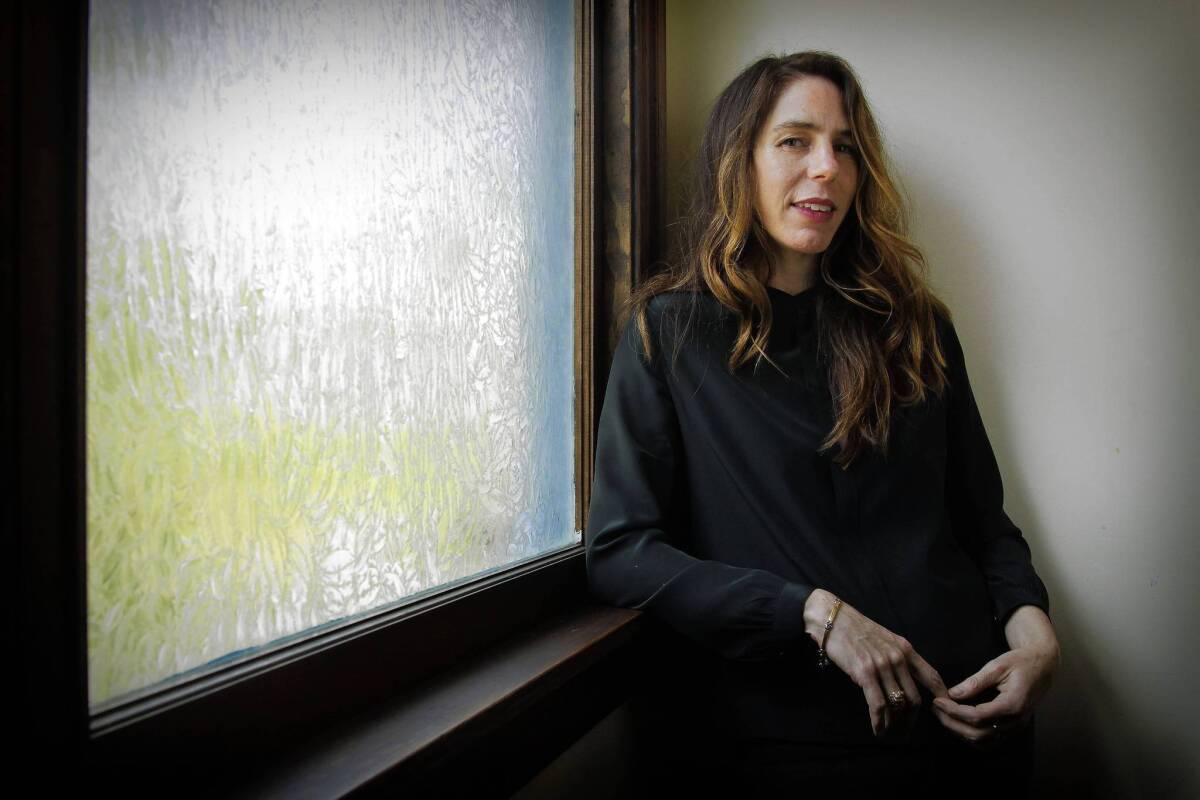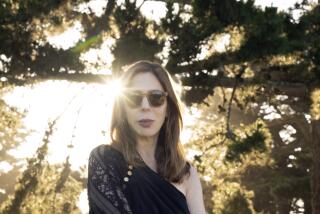Rachel Kushner lights a fire in âThe Flamethrowersâ

Rachel Kushnerâs house in Angelino Heights feels about a million miles â and a million years â from the tumult embodied in her novels. There are books on shelves and stacks of childrenâs games; in one corner, a music stand holds a beginnerâs songbook for guitar. And yet, even on a quiet afternoon in early spring, one finds traces, echoes of the broader world. Perhaps most prominent is the large framed map of Cuba, the setting for Kushnerâs first book, âTelex from Cuba,â a finalist for the 2008 National Book Award.
âThe way I would describe it is looking at the forces of history, the social, the political milieu,â she says, sitting at the dining room table, engaged, intelligent, choosing her ideas with care. âEven class for me is important, and ethnicity, because all these things pressure character. The idea that character is a bundle of timeless and essential human traits is a sort of ideology. I think character is very much a product of where you live, who you are, what is happening in that time of your life, and Iâm interested in those pressures, those forces. A political context, a social context, really determines if not who people are then how they treat one another and what they say, how they speak.â
Kushnerâs second novel, âThe Flamethrowers,â is very much an expression of these intentions, a white-hot ember of a book that takes place in Manhattan and Italy in the late 1970s, a time when each was awash in turmoil. This both is and isnât the point of the novel, which has been receiving glowing reviews and traces the experience of one woman, a young conceptual artist known only as Reno (a reference to her western origins), as she navigates these disparate landscapes, a protagonist who is a part of the action and yet always on the outside.
âYou just seemed too young,â an artist-provocateur named Ronnie tells her late in the book, after sheâs found her way to what feels like if not quite a resolution then a denouement. âAnd you were. But honestly I donât even know if youâd be different older. I like you. But thereâs something you never seem to get.â
Such a posture â a mix of worldliness and naivetĂŠ â permeates âThe Flamethrowers,â a necessary tension, given the subject matter of the novel, and one defined by Renoâs voice.
âSheâs not a rube,â Kushner observes of her narrator, âbut I wrote her experience in a way meant to be keyed to my sense of what life is like when youâre in your 20s. I think sometimes writers can get themselves into trouble trying to exert a totally controlled and super-knowing tone. This kind of knowingness is not the most promising tone to be sustained throughout a novel, to have a young woman who understands everybody and is always reading a room perfectly. For me, thereâs creative energy in trying to negotiate myself into the space of not understanding and to see what comes out of that.â
What Kushnerâs getting at is displacement, which emerges both through Renoâs experiences and the times in which she finds herself. âThe Flamethrowersâ begins with a remarkable set piece in which the character rides a motorcycle west from New York to Utahâs Bonneville Salt Flats, where she wipes out while trying to challenge a land speed record. For Reno, though, speed is just a catalyst; her real purpose is to photograph the traces left by her bike upon the earth.
âWhen we arrived at the crash site,â Kushner writes, âI saw that Iâd broken through. What seemed like endless perfect white on white was only a very thin crust of salt. Where the crust had been broken by the force of impact, mud seeped through. I photographed all this, a Rorschach of my crash.â
The implication is that art is, or should be, a provocation, that even the most abstract expression exists in (sometimes) violent reaction to the world. Kushner develops this through Reno, but also by interweaving a parallel narrative that goes back in time to trace the rise of an Italian industrialist named Valera, a former Futurist and Mussolini supporter, whose company builds the bike she rides.
âI was interested in industrial history,â Kushner explains, âbecause in the 1970s it was about to vanishâ â an anxiety that speaks to both the political unrest in Italy and the economic unrest in New York, a city beset then by financial crisis and the collapse of its manufacturing base.
To tie all this together, Kushner introduces Sandro, Valeraâs son and Renoâs lover, an artist in lower Manhattan who produces empty boxes, carefully constructed to appear mass-produced. Itâs a kind of minimalism that, Kushner notes, âwas still very much in ascendance in the 1970s, a response to the death of the industrial age in the United States of America,â made more vivid by the fact that it was being created in lofts and studios that were themselves converted industrial spaces, in which the lines between art and industry, art and commerce, had come to be irrevocably blurred.
For Kushner, such tensions have long been of interest. Born in 1968 and raised in Oregon and San Francisco (âMy parents were hippies,â she says), she spent time on the fringes of the New York art world as a teenager and later wrote about it for magazines such as Artforum and as an editor at the magazines Grand Street and Bomb. She moved to Los Angeles in 2004, and lives with her husband and young son.
The 1970s, Kushner suggests, were an especially vibrant period because so little had been codified. âI think people forget,â she says, âbut it seems like an era in which almost no one had any money in the art world. New York was still an incredibly cheap place to live. There wasnât the sense of cleanliness or law and order â these are clichĂŠs but theyâre also true.â Among the artists who inspired her were Gordon Matta-Clark, whose work involved cutting shapes into abandoned buildings, and Danny Lyon, whose photographs document the destruction of lower Manhattan in the late 1960s to make way for the World Trade Center, itself now destroyed.
âThinking about these people who were working in the vestiges of industry is fascinating to me,â Kushner says. As if to make the point explicit, she recently curated a set of images that inspired her, including work by Lyon, Jack Goldstein and William Eggleston, for the Paris Review. âI wanted to conjure New York as an environment of energies, sounds, sensations,â she writes there, describing her novel. âNot as a backdrop, a place that could resolve into history and sociology and history and urbanism, but rather as an entity that could not be reduced because it had become a character, in the manner that a fully complex character in fiction isnât reducible to cause, reason, event.â
This wide-angle focus, this sense of fiction as not just interior â what Don DeLillo, whom Kushner cites as an influence, has derided as the âaround-the-house-and-in-the-yardâ approach â but also social, marks âThe Flamethrowers,â much as it did âTelex from Cuba,â which unfolds in the lead-up to Castroâs revolution. The idea is to think of the novel as a reflection of both character and culture, as well as the uneasy ways they intersect. That perspective aligns Kushner with contemporaries such as Dana Spiotta and Hari Kunzru, but while she acknowledges the connection (âThereâs this feeling,â she says, âthat weâre all doing the same sort of work, each in our own distinct waysâ), she also shies away from easy affinities.
Something similar might be said of âThe Flamethrowers,â which juxtaposes Manhattan and Italy without equating them, or suggesting that their crises are in any way the same. âI think the stakes are actually much lower in New York,â Kushner says, voice deliberate in the waning afternoon. âItaly was almost torn apart. In New York, something was coming to an end, but it was a romantic period. Italy, I donât think of it as idealistic, but more as a moment of real potentiality that did not come to completion. I guess itâs true that in New York the writing was on the wall, but political and aesthetic stakes, theyâre just different. I wanted there to be some sense of the difference between aesthetic stakes and political stakes.â
Festival of Books: âFiction: The Social Novelâ panel info
What: âFiction: The Social Novel,â with Rachel Kushner, Jonathan Lethem and Marisa Silver.
Moderator: David L. Ulin.
Where: Seeley G. Mudd (SGM 124), USC.
When: Noon, Saturday, April 20.
Price: Free. Tickets will be available online starting 9 a.m. Sunday. There is a $1 service fee applied to each ticket reserved.
More info: latimes.com/festivalofbooks
More to Read
Sign up for our Book Club newsletter
Get the latest news, events and more from the Los Angeles Times Book Club, and help us get L.A. reading and talking.
You may occasionally receive promotional content from the Los Angeles Times.








